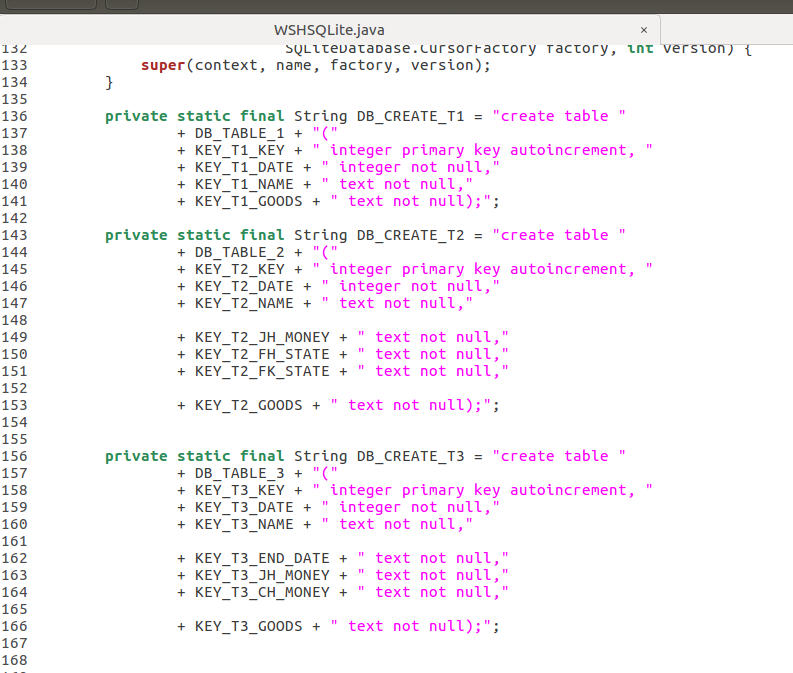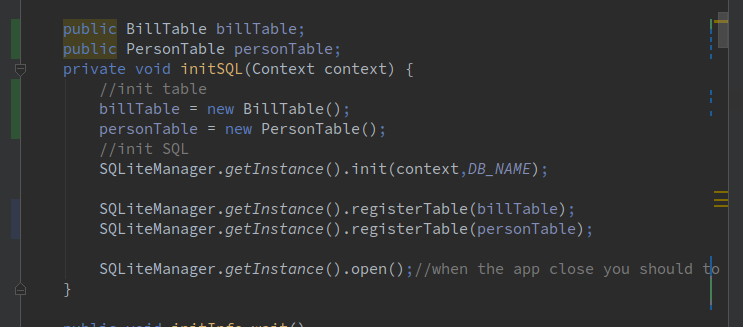Android SQLite 建表 面向物件程式設計 完美封裝 一勞永逸
Android專案開發過程中經常使用到SQLite資料對資料進行儲存,每個app都會有各自的資料DB,以及各種表項。這就意味著每次進行app開發都要編寫資料庫以及表項的建立程式碼,而這些建庫建表程式碼量往往不少,但是大多雷同,只是具體資料不一樣。僅僅拷貝後,替換都覺得麻煩。
為何不將建庫建表封裝起來呢?下次建庫或者建表時只用配置對應的資料庫名,表名以及表屬性欄位即可。
1,建庫建表
簡單來說SQLite建表就是利用SQLiteDatabase獲取DBOpenHelper 來執行相應的建表SQL語句即可。SQLiteDatabase物件容易獲取,建庫只用一條拼接後的SQL建庫一句即可,而一個庫中可以存在多張表,每張表的建表語句有些微的不同(應為表字段有差異),故建表語句數對應了需要建立的表數。下面在程式碼中體現與說明建庫建表過程。
package com.ws.coyc.wsnote.SQLiteHelper;
import android.content.Context;
import android.database.sqlite.SQLiteDatabase;
import android.database.sqlite.SQLiteException;
import android.database.sqlite.SQLiteOpenHelper;
import android.util.Log;
import com.ws.coyc.wsnote.SQLiteHelper.Utils.l;
import 上面程式碼中引用了Table物件以及Item物件,Table物件好理解就是表物件。而Item對是各個表中每個欄位對應的物件。比如說商品表中可能含有“商品名”,這個商品名就是一個item物件。程式碼如下:
package com.ws.coyc.wsnote.SQLiteHelper;
import android.content.ContentValues;
import android.database.Cursor;
import android.support.annotation.NonNull;
import java.util.ArrayList;
/**
* Created by coyc on 16-8-23.
*/
public class Table {
/*
member
*/
//table name
public String table_name;
//table strings 表屬性列表
public ArrayList<Item> items = new ArrayList<>();
//key 自定主鍵項 一般預設為“_id”
public String keyItem;
//db
public Table()
{
}
public Table(String table_name,String keyItem)
{
this.keyItem = keyItem;
this.table_name = table_name;
}
public Table(String table_name,String keyItem,ArrayList<Item> items)
{
this.keyItem = keyItem;
this.table_name = table_name;
this.items = items;
}
/*
fun 查改增刪 方法的具體實現 這裡強烈建議具體方法由子類區實現,因為不同的表所對應的查改增刪方法都有不同。
以後我們在使用的時候,我們可以讓自己的表物件繼承與Table物件,這樣專案中就很好區分各個表物件,也可以很好的管理專案中的表。
*/
//create table
//delete table
//inserte item
}
}item類
package com.ws.coyc.wsnote.SQLiteHelper;
/**
* Created by coyc on 16-8-23.
*/
public class Item {
//屬性儲存型別 比如說商品名這個屬性儲存格式可能是文字,而商品價格屬性儲存型別就可能是integer型,這個根據具體情況合理初始化item物件即可
public static final String item_type_integer = "item_type_integer";
public static final String item_type_text = "item_type_text";
public static final String item_type_long = "item_type_long";
public static final String item_type_boolen = "item_type_boolen";
public String text = "";//用於SQL拼接的關鍵字(要是無法理解可見接下來的例子)
public String type = "";//該item的型別
public Item(String text,String type)
{
this.text = text;
this.type = type;
}
public Item()
{
}
}上面就完成了對SQLite建庫建表的封裝過程,接下來只需在專案中進行簡單的配置,即可使用。做到程式碼的可移植性,以及可複用性。
目前來說程式碼結構如下:(utils包是工具包,不用管)

2,專案引用
接下來看具體的操作程式碼:
使用流程如下:
1 ,初始化SQLiteManager
2,編寫自己的Table類繼承與Table,並建立。
3,在SQLiteManager中註冊
4,執行建立表語句(SQLite在首次使用是進行建立)
5,open資料庫,進行操作
public BillTable billTable;//賬單表(這裡什麼表都行,看自己需求)
public PersonTable personTable;//使用者表
private void initSQL(Context context) {
//init table
billTable = new BillTable();
personTable = new PersonTable();
//init SQL
SQLiteManager.getInstance().init(context,DB_NAME);
SQLiteManager.getInstance().registerTable(billTable);
SQLiteManager.getInstance().registerTable(personTable);
//在執行open方法時 如果是第一次呼叫 系統則會執行建表語句
SQLiteManager.getInstance().open();//when the app close you should to close the SQL
}
//該方法呼叫完成後建表工作就都完成了我們對比一下如果不使用封裝的方法則每次專案中需要SQLite時可能效果是這樣的(這裡只是部分截圖,程式碼太多根本截不下來):

如果使用面向物件的方法的效果就會這樣的:

是不是簡單了很多!
當然我們還有寫程式碼未展示出來,接下來以personTable為例展示如何繼承Table類,重寫關鍵方法,以及Item屬性的構建。
package com.ws.coyc.wsnote.Data.Table;
import com.ws.coyc.wsnote.SQLiteHelper.Item;
import com.ws.coyc.wsnote.SQLiteHelper.Table;
/**
* Created by coyc on 16-9-9.
*/
public class PersonTable extends Table{
public static final String name = "name";
public static final String address1 = "address1";
public static final String address2 = "address2";
public static final String phone = "phone";
public static final String src_photo = "src_photo";
public PersonTable()
{
init();
}
public void init()
{
table_name = "person";
keyItem = "_id";//預設給予主鍵為“_id”
//構建屬性
items.add(new Item(name , Item.item_type_text));
items.add(new Item(address1 , Item.item_type_text));
items.add(new Item(address2 , Item.item_type_text));
items.add(new Item(phone , Item.item_type_text));
items.add(new Item(src_photo , Item.item_type_text));
}
}
public long insert(ContentValues cv)
{
return SQLiteManager.getInstance().db.insert(table_name,null,cv);
}
//delete item
public long deleteAllItem()
{
return SQLiteManager.getInstance().db.delete(table_name,null,null);
}
//
public long deleteOneByItem(String item,String content)
{
String[] args = {String.valueOf(content)};
return SQLiteManager.getInstance().db.delete(table_name,item+" =?",args);
}
//update item
public long updateOneByItem(String item,String content,ContentValues contentData)
{
String[] args = {String.valueOf(content)};
return SQLiteManager.getInstance().db.update(table_name,contentData, item+" =? ",args);
}
//上述的deleteAllItem方法可以將其放入到父類Table中去,因為這個方法可以共用,甚至insert方法也可以,這裡我就不寫回去了。但是下面這個getContentValues方法是每個類獨有的,必須重寫。因為每個表的屬性都不同。
public ContentValues getContentValues() {
ContentValues contentValues = new ContentValues();
contentValues.put("name","coyc");
contentValues.put("address1","長沙");
contentValues.put("phone","10086");
contentValues.put("src_photo","");
return contentValues;
}
寫到這裡基本上就算完成了 ,想要操作某個表時,直接使用該表物件的特定方法即可。eg:
personTable.insert(personTable.getContentValues);
3,總結:程式設計師都是很懶的,所以他們想到了封裝。寫一次程式碼以後都用現成的,想想都很好。本文中是對SQLite的建庫建表,以及對錶項的操作都使用面向物件的思想進行封裝,極大的方便以後的使用,並且讓程式碼的邏輯性更好,可讀性更高。
